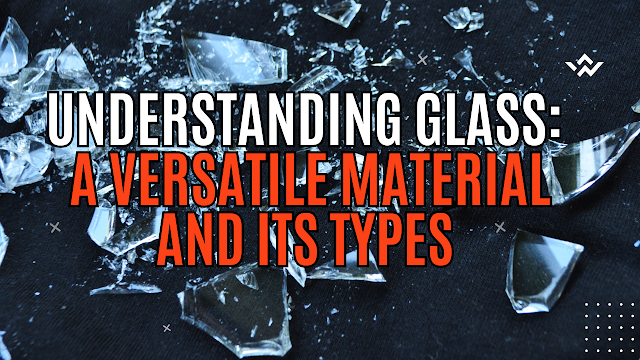Understanding Glass: A Versatile Material and Its Types
Glass is one of the most ubiquitous materials we encounter daily, found in windows, mirrors, smartphone screens, and even eyeglasses. It is a versatile material known for its transparency, durability, and ability to be molded into various shapes and sizes. But did you know there are different types of glass, each designed for a specific purpose? In this blog post, we’ll explore what glass is, how it’s made, and the different types of glass used in various industries.
What is Glass?
Glass is a non-crystalline, transparent solid that is typically made from silica (sand), soda ash, and limestone. These ingredients are heated to a high temperature until they melt and then cooled rapidly to form a solid. The process of cooling without crystallization gives glass its unique structure and properties, including its smooth, non-porous surface.
How is Glass Made?
The process of glassmaking involves four key steps:
Melting: Raw materials, primarily silica (sand), are combined with other compounds like soda ash and heated to about 1700°C (3092°F) to form molten glass.
Forming: Once molten, the glass is shaped into its desired form through processes like blowing, molding, or rolling.
Cooling: The formed glass is slowly cooled in a controlled process called annealing to reduce internal stresses.
Finishing: After cooling, the glass may undergo further treatments, such as cutting, polishing, or coating, to enhance its appearance or functionality.
Types of Glass
Depending on the purpose, glass can be categorized into several types, each with specific characteristics and uses. Let’s explore some of the most common types of glass:
1. Float Glass
Also known as soda-lime glass, float glass is the most common type used in windows, mirrors, and doors. It’s made by floating molten glass on a bed of molten tin, which produces a smooth, flat surface. Float glass can be easily cut and shaped, making it ideal for both residential and commercial use.
- Uses: Windows, mirrors, and furniture.
- Properties: Transparent, smooth surface, easily moldable.
2. Tempered Glass
Tempered glass, also known as toughened glass, is created by heating and then rapidly cooling the glass to make it stronger than standard float glass. If it breaks, it shatters into small, harmless pieces rather than sharp shards, making it safer for use in environments where breakage could pose a hazard.
- Uses: Car windows, shower doors, and phone screens.
- Properties: Strong, safe, resistant to thermal stress.
3. Laminated Glass
Laminated glass consists of two or more layers of glass with a layer of plastic in between. This type of glass holds together when shattered, as the plastic layer prevents the glass from breaking apart. It’s commonly used in situations where security and safety are priorities.
- Uses: Windshields, skylights, and security windows.
- Properties: Strong, impact-resistant, reduces noise.
4. Bulletproof Glass
Bulletproof glass is a type of laminated glass designed to withstand the force of bullets. It’s made by layering polycarbonate, a tough plastic material, between layers of standard glass. This makes it incredibly strong and difficult to penetrate.
- Uses: Banks, military vehicles, and VIP protection.
- Properties: Extremely strong, high resistance to impact.
5. Borosilicate Glass
Borosilicate glass is known for its excellent thermal resistance. Made with silica and boron trioxide, it’s capable of withstanding sudden temperature changes, making it perfect for laboratory glassware and kitchen cookware.
- Uses: Lab equipment, kitchenware (e.g., Pyrex), and lighting.
- Properties: Thermal shock resistance, durable, chemical-resistant.
6. Optical Glass
Optical glass is specially manufactured to have superior optical properties, such as high clarity and low dispersion. It is used in devices that require precise light transmission, like cameras, telescopes, and microscopes.
- Uses: Lenses, prisms, and scientific instruments.
- Properties: High transparency, excellent optical quality.
7. Colored Glass
Colored glass is created by adding metal oxides or chemicals during the melting process. It can be found in various decorative applications and can range in transparency depending on its intended use.
- Uses: Stained glass windows, glass art, and jewelry.
- Properties: Decorative, customizable colors, versatile.
8. Smart Glass
Smart glass, also known as switchable glass, uses special coatings or embedded electronics to change its transparency with an electric signal. This makes it perfect for windows or partitions in modern, energy-efficient buildings, as it can block sunlight or provide privacy on demand.
- Uses: Office partitions, privacy windows, and energy-efficient buildings.
- Properties: Dynamic transparency, energy-efficient, privacy-enhancing.
Conclusion
Glass is more than just a transparent material; it comes in various forms, each tailored to specific needs. Whether you’re using glass for safety, decoration, or scientific purposes, the type of glass you choose matters. From the common float glass in windows to the high-tech smart glass in modern buildings, this versatile material continues to evolve and innovate.
Understanding the different types of glass and their uses can help you make more informed choices for your home, office, or any other project that requires this amazing material.

Post a Comment